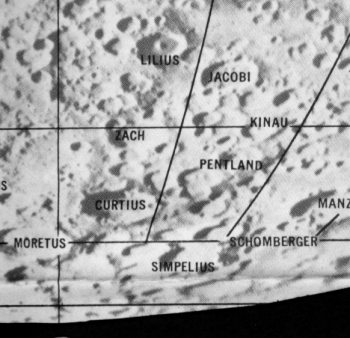First reported to the ShallowSky Maillist by Don Qualls. His write up and webcam image can be found at:
http://silent1.home.netcom.com/curtiusray.htm
If you look at Rukl 73, you'll see the crater in the rim of CURTIUS that lets the sun shine through at local sunrise. When I first saw it, the ray was (visually at least -- this crater is strongly foreshortened by being so far south) very narrow; by the time I had my webcam set up and was ready to shoot images, it was already widening slightly, and by the time I finished shooting (also took a couple shots of the Alpine Valley and a couple AVI movies) it was barely a ray, perhaps as wide as the one I spotted in Longmontanus over a year ago. This took place over a space of less than two hours, from about 18:30 to 20:00 PDT on 2000-10-5 (or about 2:30 to 4:00 2000-10-6 UT). - Don Qualls
Starting Date = 2000 / 1 / 1 U.T.
Site Longitude = 122.00 Latitude = 47.00 Elevation = 250 meters
Feature = CURTIUS
Longitude = 4°24' Latitude = -67°12'
Reproducing Lighting For: 2000 / 10 / 6 at 3 : 0 UT
Desired Solar altitude = 2.787° (Rising), Azimuth = 79.296°
Average Co-longitude = 2.809
In the time column, D=daylight, T=twilight
---- Moon's ----
Topocentric -- Earth's -- ------- Sun's -------
UT Date Time Alt° Semi-diam" long° lat° colong° lat° azim°
2000/ 1/14 6:56 12.52 949.41 -6.96 6.63 3.58 0.33 82.51
2000/ 3/13 4: 8 53.24 981.51 -1.33 4.38 359.99 -1.18 86.41
2000/ 5/11 4: 4t 54.31 971.06 4.92 -3.08 359.44 -1.41 87.00
2000/10/ 6 2:59t 20.96 900.04 0.82 -0.02 6.54 1.55 79.31
2000/12/ 4 3:19 30.19 911.43 -5.24 5.62 5.02 0.92 80.95
The colongitude of 2.809 and solar altitude of 2.787 rising was used to generate the predictions
Crater Description:
Curtius - +032,-921. This great mountain-walled depression, 50 miles in diameter, is situated a little to the west of the central meridian. It has a very massive border, rising to a great height on the south-west and also on the east, where the rampart is crowned by a bright round dome. Gigantic terraces descend to the interior, on which are a central crater, some craterlets, hills and a ruined ring on the floor close to the inner north slope. Whitaker found a cleft on the floor to the east of the central crater. On the south and west crests are craters, that on the lest being the larger; beyond it is a portion of an ancient ring now overlappped by Curtius. A chain of large and deep craters runs north from this ruined ring as far as Zach. On the south-west portion of the floor are three hillocks, or more probably cratercones, best seen under evening illumination when this part of the interior alone remains free from shadow. - Willkins and Moore, The Moon, Faber & Faber Ltd., 1955

